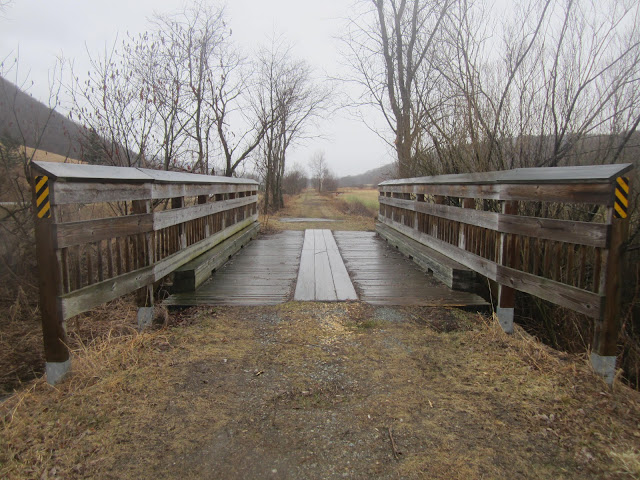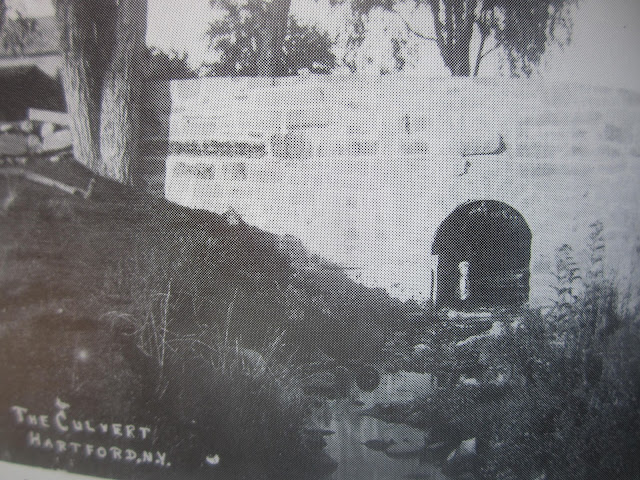First an origin story, then a final look at some of Washington County's lost spans:
Crawling along on all fours she suddenly came face to face with a snake. Startled, she sprang up on her hind legs and started to run. Pleased that standing upright helped her escape snakes (and obnoxious male members of her own species) she stuck with the two leg thing. So did her ancestors. They found that the new stance could take them far. But water crossings always proved troublesome. Speedos and the Australian Crawl hadn't been invented yet.
A few eons later her descendent stood on the bank of a stream eyeing the berries on the other side. She wanted them but didn't relish the cold dunking required to get there. Gave her goose-bumps just thinking about it. Fortunately she had inherited the 'find a better way' gene. She scoped the situation and mused "Maybe ... just maybe ..."
Summing a couple of males from the tribe (useful for their brute strength, if nothing else) she directed them to roll a fallen log into the water where the current swung it around till it jammed from bank to bank. You can guess who scooted across that first bridge and got to the berries first. And while she was slurping them down she kept picturing that log rolling towards the stream. That's when it came to her: "Might as well invent the wheel while I'm at it."
Because she wanted those berries (but didn't want to get wet) we now have lots of wheels and lots of bridges. So many bridges that some of the early ones have been abandoned. Call them 'ghost bridges' and in this third in a series post we'll look at a few more.
Last time, we shared an illustration of Burgoyne's 'bridge of boats' that he used to get his army across the Hudson. Apparently this wasn't the only floating bridge from those days. Old maps show another near the American camp area of the Saratoga Battlefield. It connected the west (Saratoga County) side with what is now Washington Counties' southwestern corner in the Town of Easton. It was located just downstream from where Mill Creek joins the Hudson at about the spot where present day Rt. 4 approaches the river in the Town of Stillwater, Saratoga County. I doubt if there is any remaining physical evidence of this span but it would be interesting to talk to rangers and historians from the Battlefield Park who may have more information about it.
A still earlier pontoon bridge turns up on maps from the 1750's. It crossed the Hudson just south of Roger's Island running from the west side to a point in the Town of Fort Edward where Lock 7 of the Barge Canal is now located. It was part of the military road that came up from Albany to Fort Edward and then went on to Lake George.
Another of the early military bridges was located just north of Washington County. Built in 1776-1777 across a narrow section of Lake Champlain, it connected Fort Ticonderoga with Mount Independence in Vermont. This one didn't float. Soldiers built at least twenty caissons (piers) and pushed them onto the ice in winter. Come spring they sank to the lake bed. Boards were laid from one to the other and anyone brave enough could walk from one side of the lake to the other! The brave (or foolish) can still scuba dive down to them in Champlain's murky waters.
Better known are the County's beloved covered bridges. Three are still carrying traffic while another is used as a museum. Many more have been lost. For anyone interested in these engineering marvels, their location and history, I highly recommend Robert McIntosh's The Covered Bridges of Washington County, New York.
Jumping ahead a few years we come to the Fenimore (aka Sandy Hill or Hudson Falls) Bridge. It was a major engineering achievement at the time it was built in 1906. The bridge was closed to traffic in 1993. The first span at the top of Bakers Falls was built in 1813 and destroyed by flood in 1835. Not sure what others existed in the intervening years.
If you stand on the new bridge that parallels the old Fenimore bridge and look upstream you'll see several piers in the river. These were built in 1836 to carry a railroad across on its planned route from Saratoga to Whitehall. Unfortunately, money ran out after the piers were built and the tracks and trestle were never finished.
Another early bridge, this one over the South Bay of Lake Champlain, has been put to use as a fishing pier.
I found another 'Then' photo of an impressive arch structure from Hartford. There's no 'Now' photo because the span is long gone.


























































